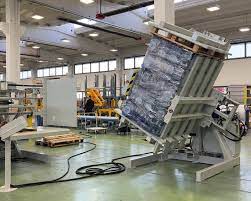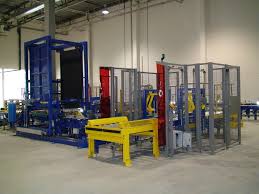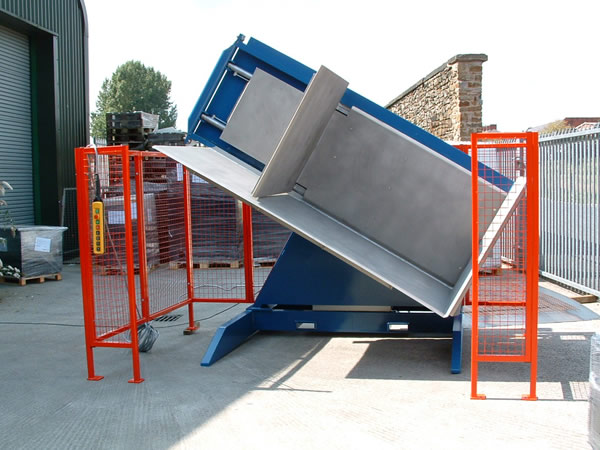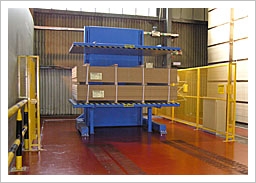Pallet Inverter: How Can Paper Mills Rotate Heavy Paper Roll Pallets?
Handling massive paper rolls is a daily reality in any paper mill. These rolls are incredibly heavy and surprisingly delicate. I've seen firsthand how a small mistake can lead to a damaged roll, costing thousands of dollars in wasted material and production delays. Worse, the risk of serious injury to your team from attempting to manually maneuver these giants is a constant worry. It's a problem that keeps plant managers up at night: how do you safely and efficiently handle these heavy loads without damaging the product or hurting your people?
A pallet inverter is the definitive solution for rotating heavy paper roll pallets in a paper mill. This machine uses a powerful and controlled mechanism to securely clamp the entire palletized load, rotate it 90 or 180 degrees, and then release it. This allows for safe reorientation, damage recovery, or pallet exchange without any manual lifting, pushing, or risk of injury.

This process might sound simple, but the impact on your operation is huge. It transforms a dangerous, slow, and wasteful task into a streamlined, safe, and efficient part of your workflow. But to truly understand its value, we need to look closer at the problems it solves and the specific ways it can benefit your facility. Let's break down why the old ways are no longer good enough and how this technology works.
Why is manual rotation of heavy paper rolls a losing game?
You see your crew gathered around a giant paper roll, trying to shift it with pry bars and brute force. You hold your breath, hoping no one's foot is in the wrong place and that the delicate edges of the paper don't get crushed. This reliance on manual methods might feel like you're saving money on equipment, but the hidden costs are piling up every single day. The constant risk, the slow pace, and the inevitable product damage are creating a huge drain on your resources. It’s time to recognize that this isn't a cost-saving measure; it's a significant operational liability.
Manual rotation of heavy paper rolls is a losing game because it exposes your business to extreme safety risks for employees, a high probability of costly product damage, and severe operational inefficiencies. These factors combine to create direct and indirect financial losses that far outweigh the perceived savings of not investing in proper equipment.

The True Cost of "Doing it by Hand"
When I started my journey as an engineer, I was taught to analyze every process. The goal was always to find the point of failure or the biggest bottleneck. In many factories, manual handling of heavy goods is that exact point. It seems straightforward, but when you break down the real costs, the picture changes completely. These aren't just one-time expenses; they are continuous drains on your profitability.
First, let's talk about safety and labor. A single paper roll can weigh over two tons. No amount of training can eliminate the risk of a crushing injury if that roll shifts unexpectedly. Even less severe injuries, like back strains from prying and pushing, lead to lost workdays, worker compensation claims, and lower team morale. A skilled operator is your most valuable asset, and putting them in a dangerous situation is a poor use of their talent. The cost of one serious accident—in medical bills, legal fees, and lost productivity—can easily exceed the cost of the right machine.
Second is the unavoidable product damage. The outer layers and edges of a paper roll are critical. Any dent, tear, or compression can render a portion of the roll useless. Manual methods using forklifts, clamps, or bars almost always result in some level of damage. Let's say you lose just 2% of a $2,000 roll due to handling damage. That's a $40 loss. If you handle 50 rolls a day, you're losing $2,000 daily, or over half a million dollars a year, straight from your bottom line. This is a conservative estimate. The damage is often much worse.
Finally, consider the operational bottlenecks. A manual process is inherently slow and unpredictable.
| Metric | Manual Rotation | Pallet Inverter Rotation |
|---|---|---|
| Personnel Required | 2-3 operators | 1 operator |
| Average Cycle Time | 10-15 minutes | 1-2 minutes |
| Safety Risk | High | Very Low |
| Consistency | Low (depends on team) | High (machine-controlled) |
| Product Damage Risk | High | Minimal to None |
As the table shows, a manual rotation that takes 15 minutes creates a massive chokepoint. The rest of your multi-million dollar production line has to wait. By reducing that time to just two minutes with a pallet inverter, you reclaim that lost time, increase your overall throughput, and allow your skilled workers to focus on tasks that add real value, not just wrestling with a paper roll.
How does a pallet inverter actually work for paper rolls?
You’ve likely heard about pallet inverters, but you might picture a violent, clunky machine. You worry that it could be too aggressive, potentially crushing or damaging the very paper roll you’re trying to protect. This is a valid concern. The thought of entrusting a valuable and heavy product to a machine can be nerve-wracking if you don't understand how it works. So, let’s demystify the process and look at the engineering that makes it both powerful and gentle.
A pallet inverter for paper rolls operates on a principle of secure clamping and controlled movement. It uses a hydraulic or electric system to press two platforms firmly against the top and bottom of the load. This pressure is adjustable to hold the roll securely without causing damage. Once clamped, the entire assembly rotates smoothly 90 or 180 degrees. The controlled motion prevents any shock or jerking, ensuring the roll and pallet remain perfectly stable throughout the process.

A Step-by-Step Mechanical Breakdown
From an engineering perspective, a pallet inverter is a beautiful example of form following function. Every component is designed for strength, safety, and precision. When I design or evaluate a piece of equipment, I look at the entire sequence of operations. It’s not just about what it does, but how it does it.
The process is simple for the operator but backed by robust engineering:
- Loading: A forklift driver places the palletized paper roll directly into the inverter's loading bay. The floor-level entry on many models makes this quick and easy, requiring no special ramps or pits.
- Clamping: The operator uses a simple control panel to activate the clamping mechanism. Two large platforms, often lined with rubber or other non-marking material, move inwards to secure the load. The key here is the adjustable clamping pressure. A system of pressure relief valves ensures that the machine applies just enough force to hold the roll securely without exceeding the crush strength of the paper. This is a critical feature we always insist on for handling sensitive products.
- Rotation: Once the load is secure, the operator initiates the rotation. A powerful hydraulic or electric motor drives the rotation smoothly and consistently. There is no sudden start or stop. The controlled speed prevents the heavy roll from shifting due to inertia, which is a major risk with jerky movements.
- Pallet Exchange and Unloading: After rotating 180 degrees, the original pallet is now on top, easily accessible. The operator can remove it and replace it with a new one. The machine then rotates back, and the forklift can pick up the roll on its new pallet. If the goal was simply to rotate the roll 90 degrees (from "eye to the sky" to "eye to the side"), the process ends there, and the roll is removed.
Key Components and Their Functions
Understanding the core parts helps you appreciate the machine's design and what to look for when choosing one.
| Component | Function | Why it Matters for Paper Rolls |
|---|---|---|
| Clamping Platforms | Secures the load from top and bottom. | Must have a large surface area to distribute pressure evenly. Soft lining is essential to prevent marking the paper. |
| Hydraulic/Electric System | Provides the force for clamping and rotation. | Hydraulics offer immense power for heavy loads, while electric systems can offer cleaner operation. The key is smooth, controllable power. |
| Control System | The operator's interface for the machine. | Must be intuitive and reliable. It should allow for precise adjustment of clamping pressure and rotation speed. |
| Safety Guards/Curtains | Prevents access to the machine during operation. | Non-negotiable safety features. Light curtains or physical fencing immediately stop the machine if an operator enters the danger zone. |
The synergy between these components is what makes the pallet inverter such an effective tool. It's not just about power; it's about controlled, precise, and safe power.
What are the key benefits beyond just rotating a roll?
It’s easy to look at a pallet inverter and think, "That's a lot of money for a machine that just turns things over." If you view it as a single-task machine, the investment can seem steep. But you might be missing the bigger picture. You're not just buying a rotator; you're investing in a solution that sends positive ripple effects across your entire operation, impacting your efficiency, profitability, and even your company culture. Let's look beyond the simple motion and uncover the true strategic value it brings to a paper mill.
The key benefits of a pallet inverter go far beyond simple rotation. They include a dramatic improvement in worker safety, a significant reduction in product damage, a measurable increase in operational throughput, and newfound flexibility in your logistics and warehousing. Together, these benefits deliver a rapid and compelling return on investment.

Quantifying the Return on Investment (ROI)
As a business owner, every major purchase has to be justified. I learned early on that the best investments are the ones that pay for themselves. A pallet inverter is a perfect example of this. The ROI isn't based on vague promises; it's calculated from hard, measurable data.
First, Reduced Labor Costs. Imagine the two or three workers you currently assign to the dangerous task of manual rotation. With a pallet inverter, that task now requires one operator for about two minutes. Those other workers can be reassigned to more productive, value-adding roles. You're not replacing people; you're elevating their work from manual labor to skilled operation, which improves both efficiency and morale.
Second, Eliminated Product Waste. As we calculated before, even minor damage to a paper roll adds up to huge losses. A pallet inverter handles the roll gently and securely, virtually eliminating handling-related damage. Saving just one roll per day could mean saving over half a million dollars annually. This is a direct contribution to your profit margin.
Third, Increased Throughput. A production line is only as fast as its slowest part. If your converting or shipping department is constantly waiting for a roll to be manually rotated, you have a bottleneck. By cutting a 15-minute manual process down to a 2-minute automated one, you unlock an incredible amount of productive time. This allows you to process more rolls per shift with the same number of staff, directly increasing your plant's capacity and revenue potential.
Gaining Strategic Advantage
Beyond the immediate cost savings, a pallet inverter provides flexibility that can make your entire operation more agile.
- Pallet Management: You can easily switch loads from high-quality in-house pallets to cheaper, one-way shipping pallets before they go to a customer. This reduces pallet loss and saves money. Conversely, you can transfer incoming goods from broken or low-quality pallets onto your own durable ones for safe internal storage.
- Damage Recovery: What happens when a forklift damages the bottom pallet of a fully loaded paper roll? Manually, it's a nightmare. With an inverter, you can simply rotate the load 180 degrees, replace the broken pallet, and have the load ready to go in minutes. This turns a potential write-off into a minor inconvenience.
- Process Integration: A pallet inverter can act as a bridge between different stages of production. For example, a roll might need to be stored "eye to the sky" but fed into a converting machine "eye to the side." The inverter makes this transition seamless, enabling better workflow design and automation. This ability to reorient heavy, valuable products is a core principle of modern manufacturing, whether it's paper rolls or steel coils.
What should you look for in a pallet inverter partner?
You've done the research. You see the value. Now, you search online and find dozens of pallet inverter manufacturers. Their machines look similar in the pictures, and the specifications seem almost identical. It’s tempting to just compare prices, but this is one of the biggest mistakes you can make. Choosing the wrong supplier can turn a smart investment into a long-term headache, leaving you with a machine that breaks down, doesn't quite fit your needs, or has zero support when you need it most. The real challenge isn't just picking a machine; it's choosing a strategic partner.
When choosing a pallet inverter, you must look for a partner, not just a supplier. This means evaluating their deep engineering expertise, their willingness and ability to customize the solution for your specific needs, their commitment to comprehensive after-sales support, and a proven track record of successfully handling heavy and sensitive products like yours.

My Insight: An Engineer's Checklist for a Supplier
Throughout my career, from an employee on the factory floor to owning my own factory, I've bought and built a lot of machinery. I've learned that the quality of the company you buy from is just as important as the quality of the machine itself. This is the checklist I use, and it's what we strive to be for our clients at SHJLPACK.
First, Customization Capability is Non-Negotiable. Your paper rolls have a specific diameter, weight, and crush strength. A standard, off-the-shelf machine might not be optimal. A true partner will ask questions. Can they adjust the clamping pressure range? Can they modify the opening size? Can they change the footprint to fit your available space? If a supplier only offers one-size-fits-all, they don't understand your business.
Second, Inspect the Build Quality and Components. Don't just look at the marketing photos. Ask for detailed specifications. What grade of steel do they use? Look at the quality of the welds. What brands are the critical components like the hydraulic power pack, the motor, and the electrical controls? Reputable manufacturers use reliable, well-known component brands because they know that a machine is only as strong as its weakest part. This focus on quality shows they are building for durability and uptime, not just a low price.
Third, Evaluate their Installation, Training, and After-Sales Support. A great partner’s job doesn't end when the machine is shipped. Do they offer on-site installation and commissioning support? Will they thoroughly train your operators and maintenance staff? What does their warranty cover, and how responsive is their service team? Ask about spare part availability. A machine is useless if it's down for weeks waiting for a simple part. This long-term support is the foundation of a real partnership.
A Lesson from the Steel Industry
This reminds me of a client I worked with, a steel mill owner named Javier. He was facing a similar challenge, but with massive steel coils, not paper rolls. He needed to upend these coils for inspection and banding. The coils were immensely heavy, and their surfaces were easily scratched, which would cause the entire coil to be rejected.
He had been quoted for a "standard" coil upender from another company. But I knew that with that kind of weight and sensitivity, "standard" was a recipe for disaster. We didn't just give him a price. We went to his plant. We measured his coils. We talked to his operators. We designed a machine with a unique V-shaped saddle lined with a special polyurethane to cradle the coil perfectly. We engineered the hydraulic system for an ultra-smooth motion.
The lesson was clear, and it's one I carry with me every day: for heavy, valuable, and sensitive products, whether steel or paper, a one-size-fits-all approach is a failure. You need a partner who listens, who understands the engineering challenges, and who builds a solution, not just a machine. That is the only way to ensure your investment truly pays off.
Conclusion
A pallet inverter is more than a machine; it is a strategic investment in safety, efficiency, and profitability for any operation that handles heavy, palletized goods.

![[Engineer’s Guide] How to Choose the Right Mold Flipper for Your Workshop? [Engineer’s Guide] How to Choose the Right Mold Flipper for Your Workshop?](https://i2.wp.com/res.cloudinary.com/dheixzr6f/image/upload/v1741318561/pallet_inverter_for_supply_chain_optimization_n0foza.jpg?w=640&resize=640,479&ssl=1)



